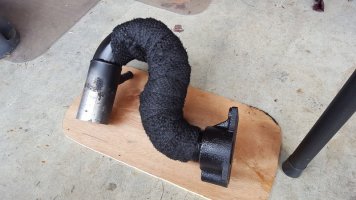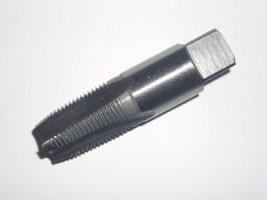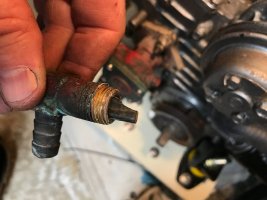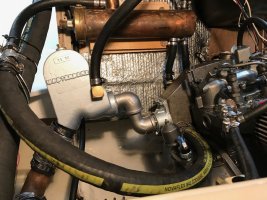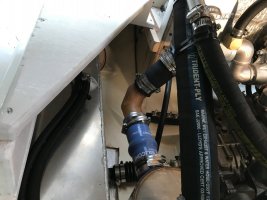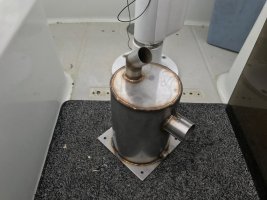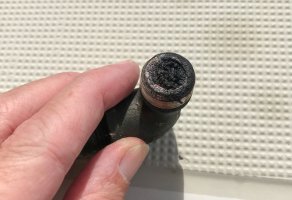After weeks or pulling things apart, it's time to start re-assembly. I have been mulling over whether to replace this:
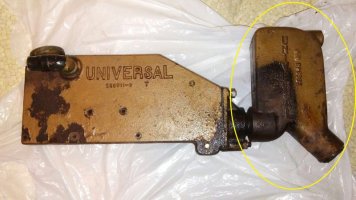 with this.....
with this.....  or with this.....
or with this..... 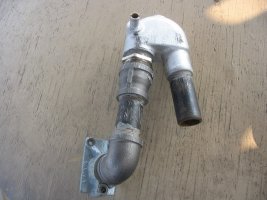 .
.
In the end, I decided on the latter Yanmar-type elbow. Like anything boat related, there are trade offs, but for me it came down to remove-ablity. The Westerbeke unit, like my original Universal elbow, twists on to a 1 1/4" threaded nipple at the exhaust flange. Since there's not room in the engine compartment to rotate the unit 360 degrees to remove it, you have to take off the exhaust flange to get it out. Not a huge deal, but it does mean having to drain the coolant, replace the flange gasket, etc. The Yanmar elbow, however, twists off from a 1 1/2" stainless nipple at the top of the riser. Something that should be easy to do in place. The 1 1/2" stainless nipple is a Yanmar designed part that is reverse-threaded on the top side, so turning the nipple in one direction removes it from both the elbow above and the 1.5"-to-1.25" pipe reducer below.
From what I've read, exhaust elbows should be cleaned out every 3-5 years to prevent this....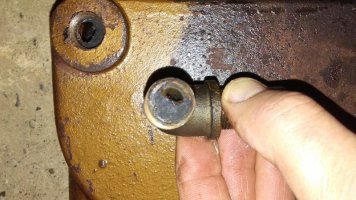 which would have readily led to an over-heated engine.
which would have readily led to an over-heated engine.
So, I have all the parts to make the Yanmar elbow. The plumbing guys, of course, recommended 316 stainless when I told them it's for a high-temp, high vibration, salt-water marine exhaust application. But, back to the trade-offs, stainless steel it turns out, is one of the worst metals for galling, or cold-welding, in threaded connections. Cold-welding my fittings together kind of kills my whole argument for remove-ability.
To prevent galling, they made two recommendations:
(1) using a high quality anti-seize paste on stainless-to-stainless fittings, or
(2) using dissimilar metals for the threaded connections: Plain-iron threaded pipe, according to my plumbing supplier, will not gall against stainless pipe. It will, however, lead to corrosion of the stainless fitting. He claimed a Bronze fitting would be the best match for the stainless nipple. Bronze-to-stainless apparently won't corrode or gall.
I see bronze in all kind of cold-water marine plumbing applications (water-line fittings, thru-hulls, etc), but i have no idea if bronze will hold up to the high heat, high vibration, and high stress (having stronger, stainless fittings inserted both above and below) in this application.
So much for the plumber's opinion.....thought I'd ask the boating experts: Stainless with anti-seize, bronze, or plain iron for the reducer fitting?

Thanks.
 with this.....
with this.....  or with this.....
or with this.....  .
.In the end, I decided on the latter Yanmar-type elbow. Like anything boat related, there are trade offs, but for me it came down to remove-ablity. The Westerbeke unit, like my original Universal elbow, twists on to a 1 1/4" threaded nipple at the exhaust flange. Since there's not room in the engine compartment to rotate the unit 360 degrees to remove it, you have to take off the exhaust flange to get it out. Not a huge deal, but it does mean having to drain the coolant, replace the flange gasket, etc. The Yanmar elbow, however, twists off from a 1 1/2" stainless nipple at the top of the riser. Something that should be easy to do in place. The 1 1/2" stainless nipple is a Yanmar designed part that is reverse-threaded on the top side, so turning the nipple in one direction removes it from both the elbow above and the 1.5"-to-1.25" pipe reducer below.
From what I've read, exhaust elbows should be cleaned out every 3-5 years to prevent this....
 which would have readily led to an over-heated engine.
which would have readily led to an over-heated engine.So, I have all the parts to make the Yanmar elbow. The plumbing guys, of course, recommended 316 stainless when I told them it's for a high-temp, high vibration, salt-water marine exhaust application. But, back to the trade-offs, stainless steel it turns out, is one of the worst metals for galling, or cold-welding, in threaded connections. Cold-welding my fittings together kind of kills my whole argument for remove-ability.
To prevent galling, they made two recommendations:
(1) using a high quality anti-seize paste on stainless-to-stainless fittings, or
(2) using dissimilar metals for the threaded connections: Plain-iron threaded pipe, according to my plumbing supplier, will not gall against stainless pipe. It will, however, lead to corrosion of the stainless fitting. He claimed a Bronze fitting would be the best match for the stainless nipple. Bronze-to-stainless apparently won't corrode or gall.
I see bronze in all kind of cold-water marine plumbing applications (water-line fittings, thru-hulls, etc), but i have no idea if bronze will hold up to the high heat, high vibration, and high stress (having stronger, stainless fittings inserted both above and below) in this application.
So much for the plumber's opinion.....thought I'd ask the boating experts: Stainless with anti-seize, bronze, or plain iron for the reducer fitting?

Thanks.

